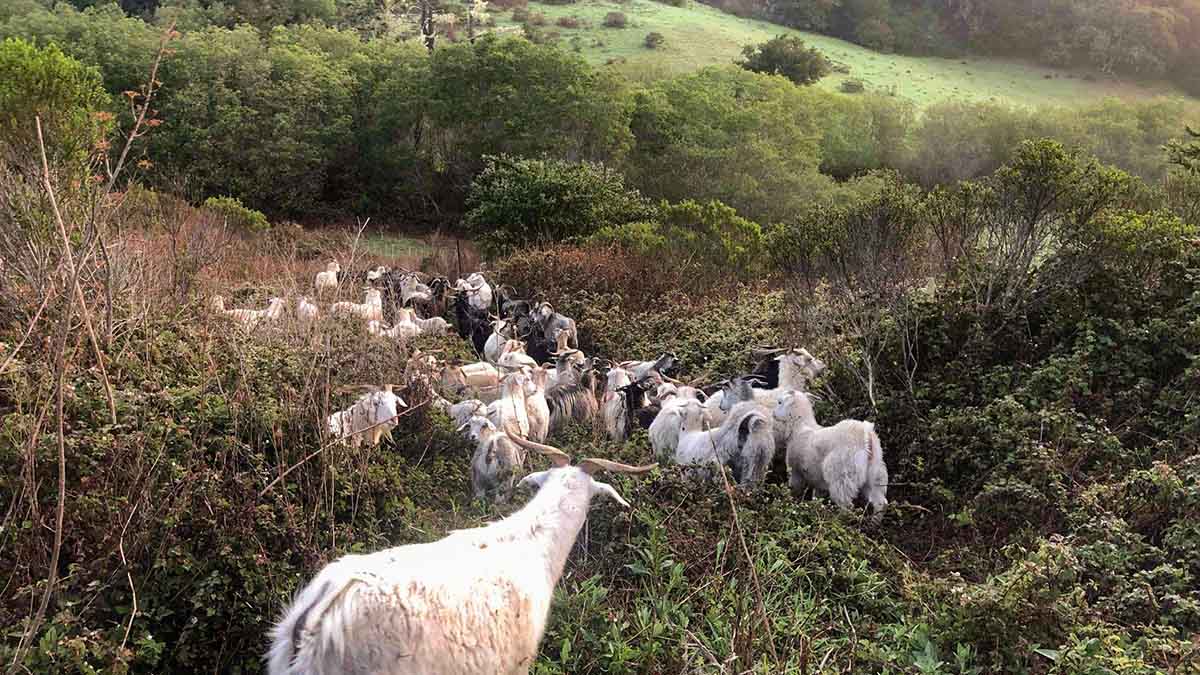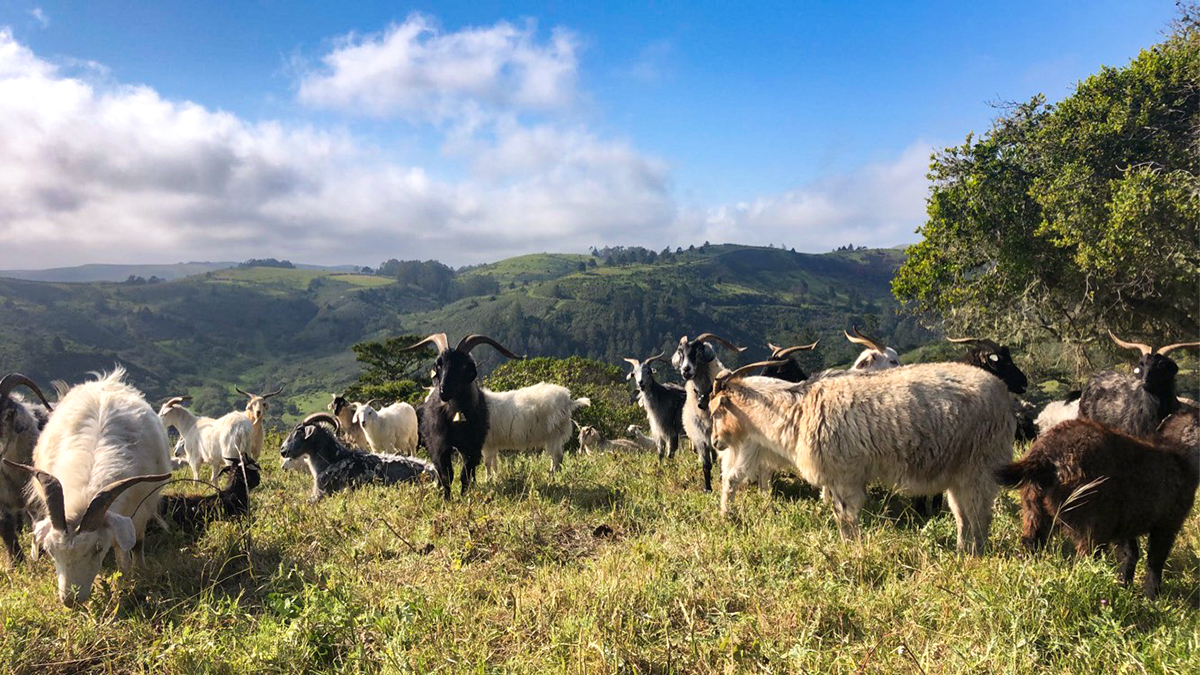The TomKat Ranch Grazing Plan Goes Multispecies – Welcome Goats!
05/03/2022
By Catherine AhSam, TomKat Ranch Apprentice
Foreword by Mark Biaggi, Ranch Manager
At TomKat Ranch, we focus on grassland ecosystem regeneration. Today, coyote brush, poison oak, and many other plants are out of balance in our landscape, especially on our rangelands due to the lack of consumption of plant material—whether by browser, fire, or animal trampling. That’s why we are trying to re-introduce the necessary tools available to reestablish balance through nature’s eb and flow of growth and disturbance.
For the past 10 years, we have adaptively managed cattle as a tool to regenerate the landscape, contribute to the science of regenerative land management, demonstrate its benefits, and inspire its adoption across California and beyond. Adaptive grazing with cattle has resulted in substantial improvements in native perennial grasses, water infiltration, and carbon sequestration. However, fully functioning natural systems never rely on a monoculture—be it plants or animals—they will thrive as diversity increases.
With herd diversity in mind, in the Spring of 2021, Lani and Donny Malmberg’s Goatapelli Foundation came to TomKat Ranch to graze their goats around fire-sensitive structures with exemplary results. While these practices are helpful for reducing fire risk and promoting ecosystem health on and around ranch infrastructure, we have decided to see if regeneratively managed goats could provide similar or complementary benefits on the broader landscape with the help of our two new apprentices, Catherine AhSam and Stephenie Pittman. Oh, and a new herd of goats!
Watch for updates by joining our email list.
– Mark Biaggi
 You may have seen these caprine creatures creating fire breaks around homes or maintaining steep hillsides along the highway. Perhaps you read an article in Vogue or Vice highlighting their versatility and the adoration they inspire in the public. More than ever, goats are being featured and praised for the beneficial impacts they create such as fire mitigation, brush clearing, weed abatement, and invasive plant eradication.
You may have seen these caprine creatures creating fire breaks around homes or maintaining steep hillsides along the highway. Perhaps you read an article in Vogue or Vice highlighting their versatility and the adoration they inspire in the public. More than ever, goats are being featured and praised for the beneficial impacts they create such as fire mitigation, brush clearing, weed abatement, and invasive plant eradication.
TomKat Ranch’s first resident goat herd arrived from the ranch of a long-standing friend of the ranch—Marissa Taylor—in Lonetree, Wyoming on February 7th, 2022. These goats are familiar with grazing without fence lines in the cold, arid Wyoming country and are truly “range goats,” moving as a herd and grazing palatable forage.
We are currently applying goat grazing to address some of the issues facing land managers and ranchers today including reducing fuel loads that create fire hazards and mitigate brush encroachment all while improving soil health thanks to the benefits that well-managed grazing animals can provide the land. As an educational foundation, TomKat Ranch intends to share its findings publicly, both through observation and monitoring.
Every fire season, ranchers face the possibility of losing land, livestock, and infrastructure unless precautions are taken. Reducing fire risk and fuel loads is an increasing priority as temperatures rise and the dry season begins earlier and lasts longer. For example, in August 2020, the CZU Lightning Complex fire came within a few miles of the TomKat Ranch property line. By the time the fire was fully controlled four months later, CalFire reported that 86,509 acres burned, 1,490 structures were destroyed, and one civilian perished in the blaze.
Land managers manage fire resilience in different ways depending on their context, including machinery, prescribed burns, and grazing. Conventional fire mitigation efforts typically use heavy machinery or hand tools to remove vegetation. However, machines burn a lot of fossil fuels, bring a risk of igniting fires while in operation, are challenged to access rugged terrain (such as rangelands on California’s Central Coast), and (unless asked to remove material from the site) often leave fuel (vegetation) on-site thereby creating a new fire risk.
Machinery, and prescribed burns are undoubtedly tools to aid in preventing fires, but perhaps, goats pose a more sustainable and long-term solution. Goats are a unique livestock species to achieve our land management goals due to a long list of characteristics and behaviors they demonstrate.
First, goats’ diets include a wide range of plants including trees, brush, thistles, noxious weeds, toxic plants, invasives, non-natives, and grasses. Unlike machinery, goats are able to eliminate fuel; they eat vegetation and convert it to dung which in turn fertilizes the rangeland and supports soil and overall ecosystem health. Goat grazing can change an ecosystem’s plant succession and biodiversity via targeting a plant species and managing for its eradication or preservation. For example, TomKat Ranch is focused on managing brush on the property such as Coyote Bush, Poison Oak, and California Blackberry. By using the goats to graze brush species, native grasses that once were crowded out have the opportunity to grow. When goats graze these woody plants (which cattle don’t care for), the plant material is digested and returned in the form of dung that will feed the bacteria in the soil and activate other plants to grow in the newly acquired space.
Second, goats can be bipedal (stand on two feet), which allows them to clear ladder fuels up to 6 feet high. Ladder fuels act as a conduit that carries fire from the ground into tall trees where flames can reach into high altitudes carrying fire into surrounding trees. Fire codes state that vegetation in a fire break be less than four inches as flames can be double the height of the vegetation. Goats standing on two feet will trample tall or woody vegetation, thereby satisfying the fire code and reducing fire risk.
Third, goats traverse treacherous terrain with ease due to their lightweight stature, aptitude for climbing, and acute sense of balance, they can navigate steep hillsides without negatively impacting the soil or leading to erosion as might happen from larger livestock such as cows.
Lastly, we are always looking for ways to reduce water use and improve the health of water cycles on the ranch in the midst of California’s ongoing drought with strategies like preserving and expanding riparian areas, applying compost to grow soil organic matter, and minimizing soil compaction and damage from tillage and over grazing. We are excited to add goats as a new part of our regenerative toolbox. In addition to their ability to graze plants that cows often cannot, goats’ small hooves can break up hard sun-baked crust on the soil surface leaving small water reservoirs to collect and diffuse water slowly. Coupled with their benefits to healthy and resilient plant communities, goats can meaningfully increase water infiltration and retention in the soil.
In conclusion, our new goat herd will work alongside our cattle to improve the rangeland’s water infiltration and holding capacity, plant biodynamics, and resiliency against fire. Our goat grazing program strives to provide insights, and be replicable, for land managers and ranchers interested in improving their landscapes and considering goats as a solution.

